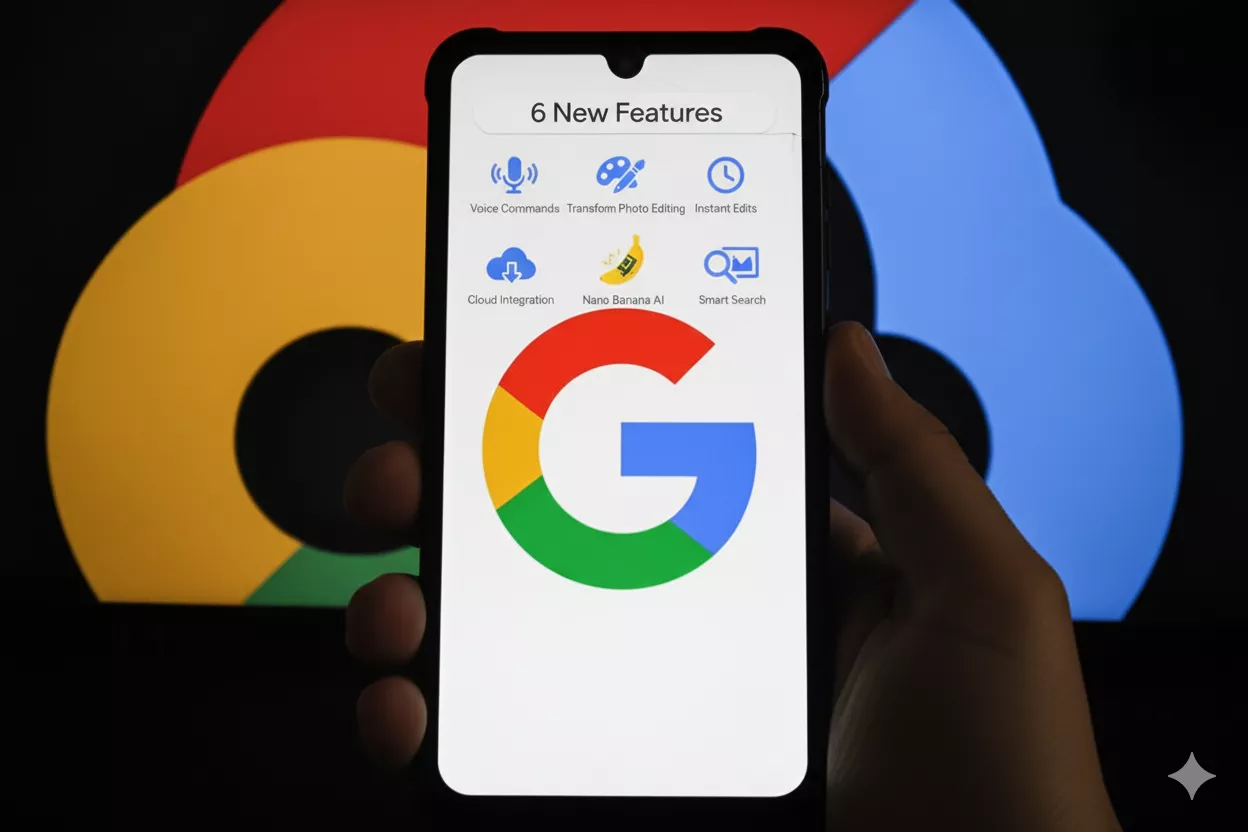Google Photos rolls out Nano Banana AI on November 11, 2025, with voice-command editing, personalized templates, and Ask Photos expansion to 100+ countries. Edit photos by simply asking.
Key Highlights
- Google Photos launched six AI-powered features on November 11, 2025, powered by Gemini’s Nano Banana model
- Voice and text commands now edit photos: “remove sunglasses,” “open eyes,” or “make someone smile” in single prompts
- Nano Banana transforms images into artistic styles like Renaissance portraits, mosaics, or storybook pages
- New “Create with AI” section offers ready-made templates for instant edits like professional headshots and holiday cards
- Personalized templates coming soon, using photo library insights to create custom edits based on hobbies and experiences
- Ask Photos expands to 100+ countries and 17 new languages for natural photo search
- Conversational editing launches on iOS in the US with redesigned photo editor
- New “Ask” button enables chatbot-style interactions directly within photos on Android and iOS
What Makes Google Photos AI Editing Different from Before
Google Photos now lets users fix photo flaws through natural conversation instead of complex tools and sliders. The Help me edit feature accepts simple text or voice commands to handle multiple edits simultaneously. For instance, you can type “Remove Riley’s sunglasses, open my eyes, make Engel smile and open her eyes” and the AI processes all three requests at once.
The system uses your private face groups to identify people accurately and generate personalized edits. This means the AI already knows who appears in your photos and can make person-specific adjustments without manual selection. Google emphasizes that face group data stays private and never leaves your device on compatible smartphones.
iPhone and iPad users in the United States can now access these conversational editing tools through a redesigned photo editor interface. The update eliminates the need to switch between multiple editing tools or adjust various sliders manually, streamlining the entire editing process into simple verbal requests.
How Does Nano Banana Transform Your Photos
Nano Banana serves as Google’s top-rated image editing model within the Gemini AI family. This technology powers creative transformations that go beyond basic photo corrections. Users can open any photo, tap Help me edit, and describe their desired artistic style in plain language.
The model handles dramatic reimagining requests like painting you as a Renaissance portrait, restyling images as colorful tile mosaics, or turning photos into children’s storybook pages. These transformations happen within seconds directly inside the Google Photos app, requiring no third-party software or extensive editing knowledge.
Google designed Nano Banana to prioritize both creativity and privacy. The model processes compatible device computations locally, keeping your photo data secure while delivering professional-grade results. This approach rivals dedicated editing software without the complexity or learning curve typically associated with advanced photo manipulation tools.
Can You Get AI Template Ideas for Quick Edits
Google added a Create with AI section to address the challenge many users face when creating their own editing prompts. This new feature appears in the Create tab on Android devices in the United States and India, offering ready-made templates powered by Nano Banana for instant results.
Popular template options include “put me in a high fashion photoshoot,” “create a professional headshot,” and “put me in a winter holiday card.” These templates work immediately without requiring users to think up creative prompts or experiment with different phrasing. Social media creators particularly benefit from these quick transformation options for generating shareable content.
Personalized templates will roll out in the coming weeks to select US regions first. These advanced templates analyze your photo gallery activity to understand your hobbies and experiences, then generate truly custom edits. Examples include “create a name doodle personalized to me” or “create a cartoon of me and my hobbies,” making AI creativity genuinely tailored to each individual user.
How Does Ask Photos Search Work Across Languages
Ask Photos brings conversational search to Google Photos, expanding to more than 100 countries and 17 new languages. This feature lets you find specific memories by asking complex questions in natural language instead of scrolling through thousands of images manually.
You can now search using phrases like “Show me beach photos from last summer with Sarah” or “photos from my college farewell.” The AI understands context, relationships between people, locations, and time periods to surface the most relevant results. This makes photo discovery feel more intuitive and significantly faster than traditional keyword-based search.
The update adds support for languages including Hindi, Bengali, and Marathi, making the technology accessible to millions more users worldwide. A new Ask button appears when viewing individual photos, enabling instant conversations about image content, discovering related moments, or requesting edits without leaving the photo view. This integration creates a seamless experience between searching, viewing, and editing within the same interface.
When Will These Features Be Available Globally
Google began rolling out all six features on November 11, 2025, with complete global availability expected throughout the week. The conversational editing feature for iOS devices launches first in the United States before expanding to additional regions. Android users in the US and India can access the Create with AI templates immediately.
Ask Photos expansion to 100+ countries happens in phases over several days, ensuring system stability as millions of users gain access to the conversational search capabilities. Personalized templates will arrive in the coming weeks, starting with select US regions before broader deployment.
Users need to update their Google Photos app to access these new features. Compatible devices include recent Pixel smartphones and flagship Android or iOS phones that support on-device AI processing. The staged rollout approach helps Google manage server load while gathering user feedback to refine the AI models before worldwide availability.


